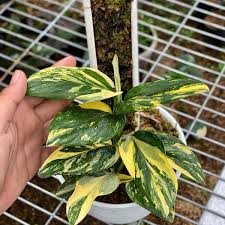If you love the look of Monsteras but crave something a little less common, the Monstera standleyana might be your perfect match. With its elegant, elongated leaves and splashes of variegation (if you’re lucky!), it adds a touch of exotic elegance to any indoor space. Let’s dive into how to help your Monstera standleyana thrive.

Key Elements of Care
- Light: Bright but Indirect is Best Just like other Monsteras, the standleyana loves bright, indirect light. Think filtered sunlight through a rainforest canopy. An east or west-facing window is ideal, or soften light exposure with a sheer curtain. Direct sun can scorch those delicate leaves, while too little light hinders its growth and variegation.
- Watering: The “Soak and Dry” Method Allow the top few inches of soil to dry before giving your Monstera standleyana a thorough watering. Overwatering is a common mistake, so err on the side of slightly underwatering to avoid root issues.
- Humidity: A Tropical Craving Monstera standleyana adores humidity! Aim for levels above 50% to keep those leaves lush and happy. Use a humidifier, a tray filled with water, or put it with other humidity-loving plants.
- Soil: Well-Draining and Supportive A chunky, airy aroid mix provides the necessary drainage and good air circulation for roots. You can find pre-made mixes at many garden centers or create your own simple blend using ingredients like coco coir, perlite, orchid bark, and a bit of potting soil.
Encouraging the Best Growth
- Climbing Ambitions: In the wild, Monstera standleyana is a climber. Providing support like a moss pole or wooden trellis encourages healthy upward growth and showcases the plant’s full potential.
- Fueling Growth with Nourishment During spring and summer, treat your Monstera standleyana to a diluted, balanced liquid fertilizer about once a month. Choose a fertilizer suitable for aroids or general foliage plants, and follow the dilution instructions.
- Temperature: Warm and Cozy This tropical plant thrives in temperatures between 65-85°F. Protect it from cold drafts, as they can cause stress and leaf damage.
Troubleshooting and FAQs
- Why Isn’t My Standleyana Variegated? Variegation in Monstera standleyana is genetic and varies from plant to plant. Some might boast striking white or yellow splashes, while others may be entirely green. Provide the best light possible to encourage existing variegation.
- Why Are My Leaves Turning Yellow? Yellowing leaves can point to overwatering, underwatering, insufficient light, or a need for nutrients. Investigate each potential cause and adjust your care accordingly.
- Common Pests and Management Like many houseplants, your Monstera standleyana could attract spider mites, scale, or mealybugs. Inspect your plant regularly and treat infestations early with natural insecticidal soaps or neem oil.
Monstera Standleyana Propagation: Multiply the Beauty!
Propagating your Monstera standleyana is a rewarding way to share this beautiful plant. Here’s the basic method:
- Locate a Node: Find a healthy node (a brown bump) along the stem where a leaf or aerial root emerges. Each node has the potential to grow into a new plant.
- Cut and Propagate: Cut a stem section with at least one node and a leaf. Choose between water propagation (in a jar) or directly planting it in moist, well-draining potting mix.
- Patience and Light: Place your cutting in a warm spot with bright, indirect light. Roots should develop within a few weeks.
Conclusion The Monstera standleyana brings a unique and elegant touch to any indoor jungle. With a bit of understanding and attentive care, you’ll be rewarded with lush growth and perhaps even those beautiful splashes of variegation. Imagine a mature specimen climbing gracefully – a testament to your green thumb and a truly captivating sight!
Leave a Reply